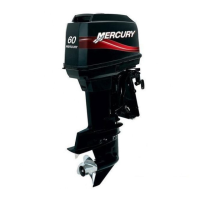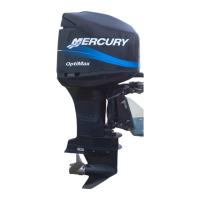EMISSIONS
Page 3C-2 90-857138R1 MAY 2000
Exhaust Emissions Standards
Through the Environmental Protection Agency (EPA), the federal government has estab-
lished exhaust emissions standards for all new marine engines sold in the U.S.
What Are Emissions?
Emissions are what comes out of the exhaust system in the exhaust gas when the engine
is running. They are formed as a result of the process of combustion or incomplete combus-
tion. To understand exhaust gas emissions, remember that both air and fuel are made of
several elements. Air contains oxygen and nitrogen among other elements; gasoline con-
tains mainly hydrogen and carbon. These four elements combine chemically during com-
bustion. If combustion were complete, the mixture of air and gasoline would result in these
emissions: water, carbon dioxide and nitrogen, which are not harmful to the environment.
But combustion is not usually complete. Also, potentially harmful gases can be formed dur-
ing and after combustion.
All marine engines must reduce the emission of certain pollutants, or potentially harmful
gases, in the exhaust to conform with levels legislated by the EPA. Emissions standards be-
come more stringent each year. Standards are set primarily with regard to three emissions:
hydrocarbons (HC), carbon monoxide (CO) and oxides of nitrogen (NOx).
Hydrocarbons – HC
Gasoline is a hydrocarbon fuel. The two elements of hydrogen and carbon are burned dur-
ing combustion in combination with oxygen. But they are not totally consumed. Some pass
through the combustion chamber and exit the exhaust system as unburned gases known
as hydrocarbons.
Carbon Monoxide – CO
Carbon is one of the elements that make up the fuel burned in the engine along with oxygen
during the combustion process. If the carbon in the gasoline could combine with enough
oxygen (one carbon atom with two oxygen atoms), it would come out of the engine in the
form of carbon dioxide (CO
2
). CO
2
is a harmless gas. But carbon often combines with insuffi-
cient oxygen (one carbon atom with one oxygen atom). This forms carbon monoxide, CO.
Carbon monoxide is the product of incomplete combustion and is a dangerous, potentially
lethal gas.
Oxides of Nitrogen - NOx
NOx is a slightly different byproduct of combustion. Nitrogen is one of the elements that
makes up the air going into the engine. Under extremely high temperatures it combines with
oxygen to form oxides of nitrogen (NOx). This happens in the engine’s combustion cham-
bers when temperatures are too high. NOx itself is not harmful, but when exposed to sunlight
it combines with unburned hydrocarbons to create the visible air pollutant known as smog.
Smog is a serious problem in California as well as many other heavily populated areas of
the United States.
Controlling Emissions
There are two principle methods of reducing emissions from a two-stroke-cycle marine en-
gine. The first method is to control the air/fuel ratio that goes into the combustion chamber.
The second is to control the time when this air/fuel mixture enters the combustion chamber.
Timing is important, to prevent any unburned mixture from escaping out of the exhaust port.

